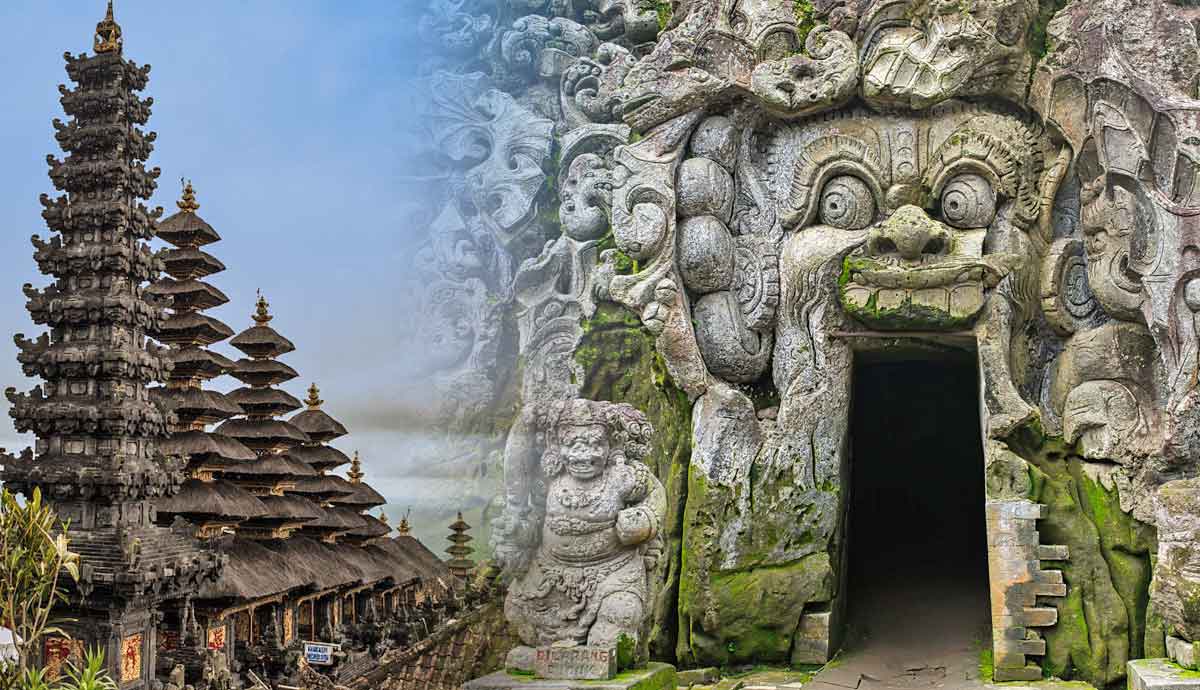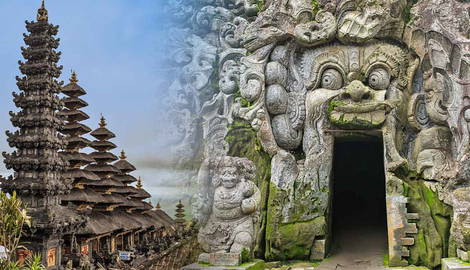
Bali, Indonesia, is one of the world’s most visited islands. A stomping ground for beachgoers, surfers, and influencers, Bali has earned a reputation as a tourist hotspot. However, Bali is much more than just the sun and fun. This Hindu island is a rich, diverse cultural beacon for the Indonesian archipelago, begging to be discovered by surfers and culture seekers alike. The sites might not be easy to get to, as the island covers an area of 5,780 square kilometers (2,231 miles), but rewards await Bali’s travelers if they exercise patience and endurance.
1. Uluwatu Temple

This Balinese Sea temple, located in the surf-friendly area of Uluwatu, is famed for its Kecak fire dance show. Set on a colossal cliff, the temple is steeped in historic splendor and covered in hundreds of mischievous monkeys.
Evidence shows that this temple existed before the 11th century, but the Javanese sage Empu Kuturan significantly expanded it. The temple also caught the eye of another Javanese sage, Dang Hyang Nirartha. Dang Hyan Nirartha spent time meditating on the cliffs and later developed the temple even further. Hindus on the island believe the temple to be the meeting point of the three powers of the Hindu Trinity: Brahma, Vishnu, and Siva. To this day, Uluwatu Temple is still considered one of the most important temples on the island.
No trip to Bali is complete without witnessing the temple’s famous Kecak Dance performance that occurs nightly at sunset. Also known as the Bali Fire dance, the dance in its most current form came to fruition in the 1930s after a local dancer and German artist collaborated. The dance today reimagines the story of Ramayana, and the theatrical display has become synonymous with Bali.
2. USS Liberty Shipwreck

Bali is a diver’s paradise, not just for the marine life but also for the exciting wreck dives available on several parts of the island. In Tulamben, on the Eastern part of the island, sits the underwater grave of the USS Liberty. The Liberty’s wreck site is one of the most famous in the world and an easy dive for even beginner scuba divers — snorkelers may enjoy the top parts of the site as well.
The Liberty was an American cargo ship during World Wars I and II. During a trip to the Philippines in 1942, the Liberty was torpedoed by the Japanese in the Lombok Strait. The ship did not initially sink and was towed to Bali, where the US military hoped they could salvage the vessel and put it back into action.
The ship sat in Tulamben, Bali, for 20 years, almost entirely untouched. It wasn’t a military act that sent the ship to the bottom of the sea; an eruption from the nearby volcano, Mount Agung, sent the ship back to sea. After laying dormant for over 100 years, the volcano erupted. The eruption caused subsequent earthquakes and the ship slipped into the water. Today, the USS Liberty wreck is home to over 400 fish species and a significant coral reef.
3. Goa Gajah Temple

A 15-minute drive from the bustling spiritual Ubud center lands you at Goa Gajah. Often referred to as the “Elephant Cave Temple,” Goa Gajah’s history is relatively uncertain. The site originated as a meditation haven for monks in the 9th century. Historians believe the temple was built in the 11th century. The temple is essential for both religions due to the heavy influence of Hindu and Buddhist design elements.
The temple’s mysterious past and beautiful gardens allow visitors to soak in the mystifying ambiance. The inside of the temple feels like stepping back through time with interesting sculptures, a meditation cave with a carving of Lord Ganesha, and traditional offerings. You may also admire the way the temple has become one with the nature surrounding it.
4. Tanah Lot Temple

Tanah Lot Temple, located not far away from the bustling tourist hot spot centers of Canggu and Seminyak, is branded as the temple where “Bali’s spirit meets the sea.” Tanah Lot is one of Bali’s seven sea temples, and the mystical site is set atop a rock formation with a history dating back to the 16th century.
According to Balinese mythology, Dang Hyang Nirartha, the temple’s creator, used his mighty supernatural powers to move the rock to its current resting place to worship the sea god, Bhatara Segara. Legend also states that Bhatara Segara created snakes from his sash to protect the sacred site. These are the same sea snakes that still guard the temple today.
Tanah Lot is famous for its sunset views; however, sunset is also the busiest time of day for seeing the temple. For a more relaxed experience, beat the crowds and check out the temple in the early morning before the crowds descend on this picturesque Balinese temple.
5. Ubud Art Market

In the spiritual hub of the jungles of Ubud lies one of the most historical shopping destinations in the entirety of Bali. Ubud Art Market, locally known as “Pasar Seni Ubud,” provides an array of goods for art and retail enthusiasts. While the current iteration of the Ubud Art Market might be more modern, the original concept came to fruition in the 1800s.
The King of Ubud during that time, Tjokorde Kandel, wanted a place near the famed Ubud Palace where goods could be traded and bartered for. Tjokorde Kandel originally created the market to bring prosperity and trade to the region — and it has succeeded in doing so.
Now, the market has two functions: The art market is primarily for tourists to the Ubud area, and the traditional market is meant for locals, although tourists can still visit. Visiting the Ubud Art Market is an exhilarating experience and a place to flex your bartering muscles. To really impress the locals, delight them with a lovely “Terima Kasih” or thank you in Indonesian upon making a purchase.
6. Tirta Gangga

Tirta Gangga is one of the most ornate historic stops in Bali. It is known for its fantastic influencer photo opportunities and the exciting history surrounding this former royal palace. Tirta Gangga is located in the Eastern part of Bali, a much quieter part of the island.
Named after the sacred Ganges River in Hinduism, this water palace was first constructed by the King of Karangasem, Anak Agung Anglurah Ketut Karangasem, in 1946. In 1963, Tirta Gangga was almost wholly destroyed when nearby Mount Agung erupted but, luckily, sustained minimal damage.
What makes Tirta Gangga worth the trek to the Eastern part of the island is one of the most unique experiences for any Bali traveler: a dip in the former royal pools. The temple’s many fountains are not for swimming; however, visitors can choose to bathe in two of the palace’s rectangular pools. Initially constructed for the royal family and their guests, now anyone can experience the royal treatment at Tirta Gangga.
Another unique feature of the temple is the fountain, which houses hundreds of koi fish that visitors can feed. Or, simply step onto the nearby stones for an iconic Bali photo opportunity.
7. Pura Tirta Empul

Located near the heart of Bali’s cultural hub of Ubud is Pura Tirta Empul. This major temple complex, considered one of the five most holy temples on the entirety of the island, houses holy springs and has been in use since 926 CE. Built by King Sri Candrabhayasingha Warmadewa of the Warmadewa dynasty, Balinese Hindus believe the Hindu God of Water blesses the temple’s water and can purify all who bathe there.
According to the temple’s mythology, the Hindu God of rain and storms, God Indra, created the water while fighting with the evil King Mayadenawa. Indra made the water to heal his poisoned troops so they could continue to fight and overthrow the King.
The temple is one of the largest and busiest temples in Bali. While considered sacred, tourists can still participate in the ancient bathing ritual. Those found standing in line to perform the melukat ritual have included not only everyday tourists but also the likes of the Obamas and, more recently, the pop singer Usher.
8. Pura Besakih Temple Complex

Pura Besakih Temple Complex is the largest and most sacred in Bali. Located 100 kilometers (62 miles) above sea level in the Eastern part of the island on the slopes of Mount Agung, it houses 23 temple complexes and 86 total temples.
The origins of the complex are historically opaque; however, the stone bases of some temples show indicators that they are likely at least 2,000 years old as they resemble stepped pyramid structures from that time period. The first recorded history of the complex was in 1007 CE, as shown in an inscription.
In 1264, the first Javanese settlers came to Bali and found the complex being used for Hindu worship. The complex later became a temple of power for the Gelgel Dynasty, which dominated the region until the late 1600s.
The temple complex centers around the Balinese belief in “Tri Hita Kirana,” which centers on the three ways of obtaining happiness and harmony: with others, God, and nature. Each year, at the end of the Balinese 210-day calendar, during the full moon, the temple is beautifully decorated for the festival of Odalan, the year-end celebration for Indonesian Hindus.










